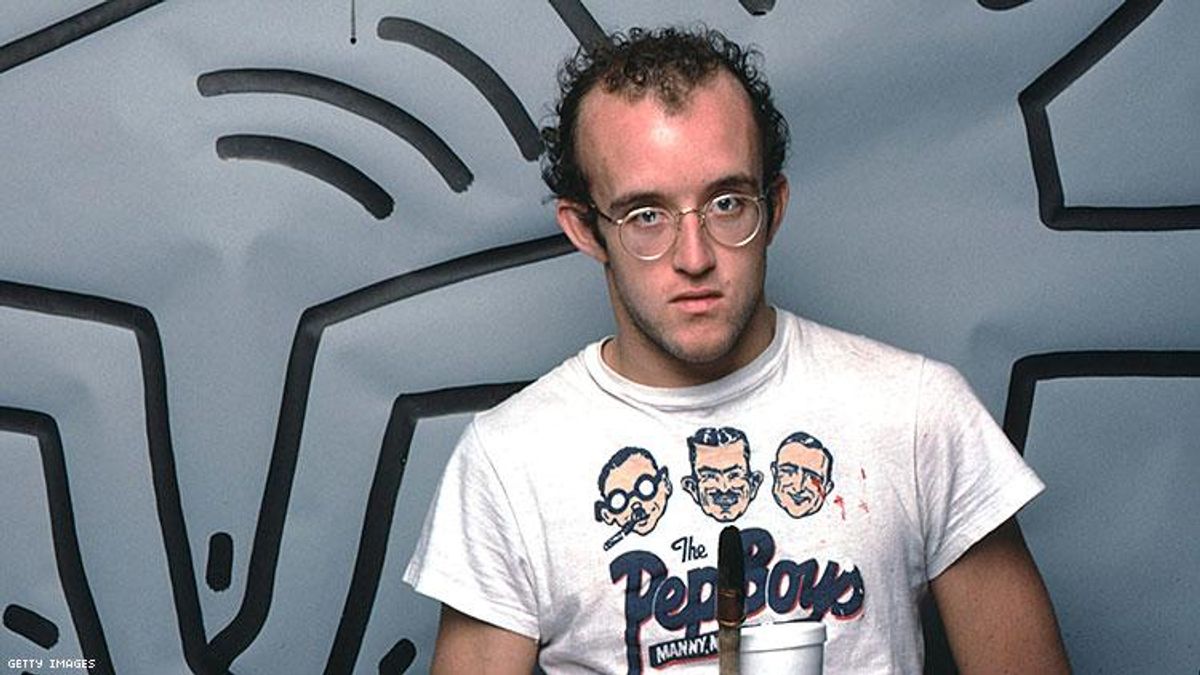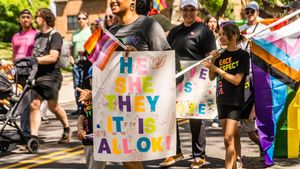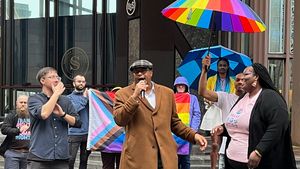Since Keith Haring's death due to AIDS-related complications in 1990, the artist's work has leapt from the sides of buildings to the front of t-shirts, laces of shoes, and the backs of ball gowns. As Haring's images have increased in popularity, they've also become divorced from their emergent context: New York's Lower East Side in the 1980s. And it was the Black and Latinx, specifically Puerto Rican, community that imbued his work with a deeper meaning. "[Haring's work] was always meant to detach itself from whatever space it emerged," Ricardo Montez, author of the forthcoming book Keith Haring's Line: Race and the Performance of Desire, says.
The economically devastated Lower East Side was a multicultural melting pot when a 20-year-old Haring, the son of a cartoonist, arrived in 1978 from Pittsburgh. He encountered new inspiration in the graffiti of the proto-hip-hop cultural environment. He would chalk drawings onto vacant, black subway ad space, hoping to "continue the line" begun by other artists. And he became especially enamored with the tag of LA2, a 13-year-old Puerto Rican street artist named Angel Ortiz, in 1980. The two embarked on a collaborative spree that comprised hundreds of works -- including faux archeological artifacts.
"He didn't treat [Ortiz] like some little kid. He respected him and gave him half of whatever they collaborated on," says Kenny Scharf, an artist and friend of Haring's. And yet, the younger artist's acclaim never came close to Haring's. In 2008, Ortiz told The New York Times that he was paid for work he helped create during Haring's lifetime, but he hadn't seen any of the profits from Haring's estate since his death. According to Montez, the Haring Foundation and the art world have since made strides to rectify LA2's erasure.
Outside of the East Village, Haring found a sanctuary at the Paradise Garage, an influential New York City club that became a mecca for queer Black and Latinx youth. Its DJ, Larry Levan, had a unique mixing style that incorporated "peaking," or leading a group of people toward spiritual transcendence. He'd stop the music for upwards of five minutes until people would stomp the ground in unison, causing the building to vibrate. Haring would later adorn the Garage's walls with his famous dancing homeboys.
"Haring must have felt as if the subject of so many of his drawings and paintings, those utopian homoerotic chains of homeboys dancing, had somehow come alive and were inviting him to participate," says Arnaldo Cruz-Malave, author of Queer Latino Testimonio, Keith Haring, and Juanito Xtravaganza: Hard Tails. He notes that critics saw Haring's entry to the Paradise Garage as similar to French painter Paul Gaugin's arrival in Tahiti. Gaugin's art, sensual paintings of indigenous people, is considered prototypical cultural appropriation.
Today's commercialism can make it hard to revere Haring's work for its original intentions -- but the artist was aware of that tension while alive. In 1986, he opened the Pop Shop to display and sell his art in the Lower East Side. Haring also made untagged art on subways and produced ads for Absolut Vodka to expose more people to his art. "The use of commercial projects has enabled me to reach millions of people whom I would not have reached by remaining an unknown artist," he said. "I assumed, after all, that the point of making art was to communicate and contribute to culture."
In absorbing the Black and Latinx culture surrounding him and infusing it into his work, it lives on through people's clothes, the prints on their walls, and the ink on their skin. If the original energy is lost in translation, Montez says, that's not a fault of Haring's -- but in how we memorialize artists.
This article appears in Out's May issue featuring artist Zanele Muholi and model Ruth Bell as cover stars. The issue is guest edited by Kimberly Drew. To read more, grab your own copy of the issue on Kindle, Nook, Zinio or (newly) Apple News+ today. Preview more of the issue here and click here to subscribe.




















































































Cooper Koch and twin bro spark controversy with eye-popping 'White Lotus' parody